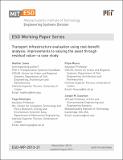| dc.contributor.author | Jones, Heather | |
| dc.contributor.author | Domingos, Tiago | |
| dc.contributor.author | Moura, Felipe | |
| dc.contributor.author | Sussman, Joseph M. | |
| dc.date.accessioned | 2016-06-06T16:08:11Z | |
| dc.date.available | 2016-06-06T16:08:11Z | |
| dc.date.issued | 2014-08 | |
| dc.identifier.uri | http://hdl.handle.net/1721.1/102983 | |
| dc.description.abstract | Residual value (RV) is an important component of Cost Benefit Analysis (CBA), often valued at 20% to 50% of total construction costs. It is often overlooked which can artificially depress the project?s returns. The treatment of RV is inadequate and needs further research. Residual value represents the value of the infrastructure at the end of its project lifetime and the value that the asset generates from then on. We analyze three methods for calculating RV: straight-line depreciation, annuity/perpetuity and component.
The straight-line depreciation method is the most commonly used; it is simple and quick to produce and it typically uses a percent of the total construction cost rather than real value. The perpetuity/annuity method ignores the actual value of the asset. It reflects the difference of costs and benefits between economic and useful life (annuity method) or assumes an infinite economic life (perpetuity method). The component method is the most detailed and difficult to calculate method. It gives the actual value of the physical asset at the end of project appraisal by infrastructure component. We assume three scenarios for the future for the component method.
We use the case study of the Portuguese High Speed Rail project to calculate and compare each method. As expected, the perpetuity has the highest RV and net present value (NPV), followed by the annuity method and then the component method. The straight-line method produces the lowest values (other than one scenario for the component method).
Sensitivity analysis is performed ceteris paribus for the demand, construction cost and discount rate factors. We conclude that RV is important in situations when the benefit-cost ratio is close to 1 and the method selected can have a large impact on the size (and sign) of the NPV. | en_US |
| dc.language.iso | en_US | en_US |
| dc.publisher | Massachusetts Institute of Technology. Engineering Systems Division | en_US |
| dc.relation.ispartofseries | ESD Working Papers;ESD-WP-2013-21 | |
| dc.title | Transport infrastructure evaluation using cost-benefit analysis: improvements to valuing the asset through residual value—a case study | en_US |
| dc.type | Working Paper | en_US |
